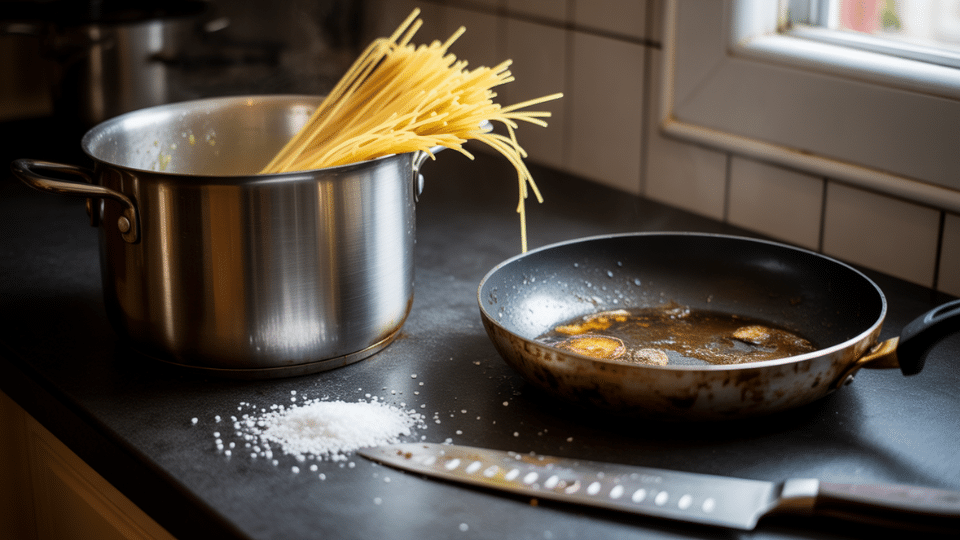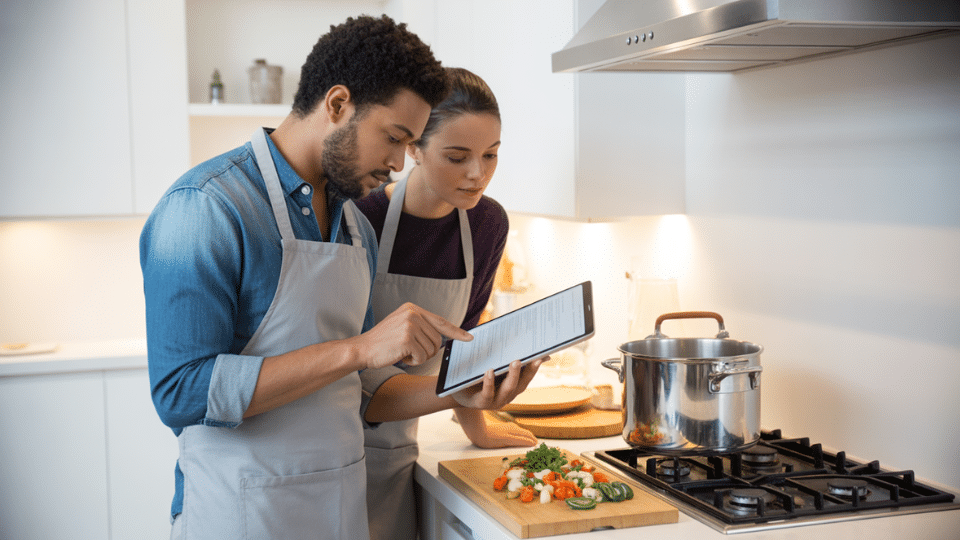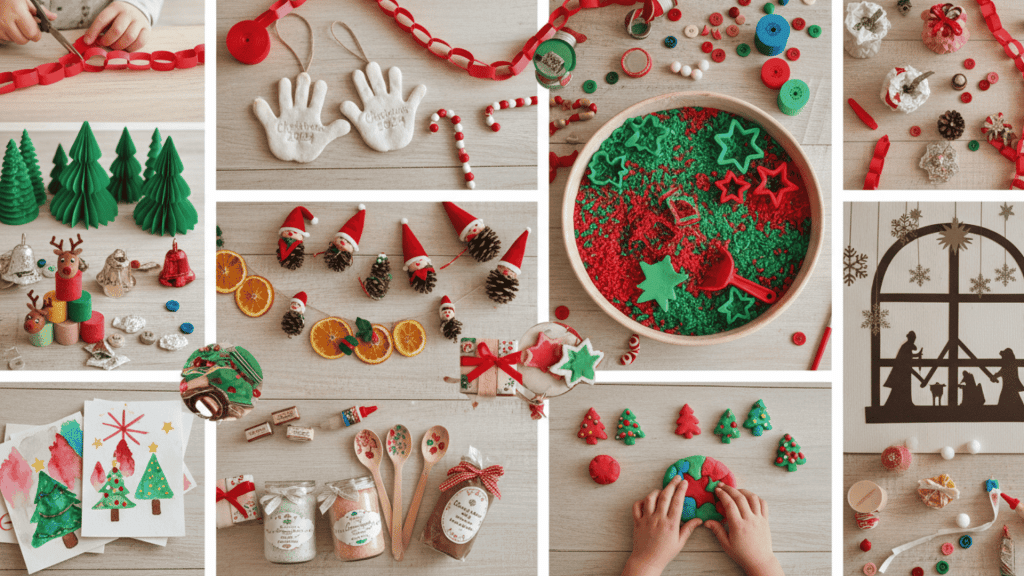Have you ever felt lost in the kitchen, staring at a recipe with mounting frustration?
Cooking can seem like a complex maze for beginners, filled with unexpected challenges and potential disasters.
Every home cook starts somewhere, and mistakes are part of the learning journey.
In this blog, I’ll show you the most common cooking mistakes that trip up newcomers, along with practical tips to help you navigate the culinary world with confidence.
From knife skills to seasoning techniques, these insights will change your kitchen experience.
If you are looking to refine your skills, these tips will help you cook more efficiently and enjoy the process.
15 Kitchen Mistakes Most Beginner Cooks Make Ahead

Turning kitchen chaos into culinary confidence, one mistake at a time. Learn, laugh, and level up your cooking skills with these essential tips.
1. Skipping Mise en Place
Mistake: Mise en place means “everything in its place” in French. Jumping into cooking without organizing ingredients and tools leads to kitchen chaos, burnt food, and missed steps.
Many beginners start cooking frantically, searching for ingredients mid-recipe, which disrupts the entire cooking process and increases stress.
Solution: Prepare everything before turning on the stove. Chop vegetables, measure spices, and arrange tools within reach.
Read the entire recipe first. Create a systematic workspace by laying out ingredients in the order they’ll be used, ensuring a smooth and controlled cooking experience.
Tip: Use small color-coded bowls to separate and organize pre-measured ingredients. Line them up in the sequence you’ll use them, transforming your cooking from chaotic to professional.
2. Using Dull Knives
Mistake: Working with blunt knives that require more force increases the risk of slipping and potential injuries during food preparation.
Dull knives crush instead of slicing, leading to uneven cuts and reduced cooking precision.
Solution: Invest in a quality knife sharpener or professional sharpening service. Learn proper knife maintenance techniques.
Regularly hone your knives before each use and replace them when they become excessively worn or damaged.
Tip: Perform a paper test to check knife sharpness. A sharp knife will slice through paper cleanly and smoothly without tearing or requiring excessive pressure.
3. Not Preheating the Pan
Mistake: Placing ingredients in a cold pan, which results in uneven cooking, soggy textures, and a lack of proper browning.
Many beginners rush to start cooking without allowing the pan to reach the correct temperature.
Solution: Always preheat your pan before adding ingredients. Use medium-high heat for most cooking tasks.
Learn to recognize the right temperature by using the water droplet test or watching for a slight shimmer in oil.
Tip: Different pans require different heating times. Cast iron takes longer to heat than non-stick pans, so adjust your preheating technique accordingly.
4. Overcrowding the Pan
Mistake: Cramming too many ingredients into a single pan, which prevents proper browning and creates steam instead of a crisp sear. This leads to soggy, poorly cooked food with minimal flavor development.
Solution: Cook in batches if necessary. Leave space between food items, ensuring each piece has direct contact with the pan’s surface.
Use larger pans or multiple cooking vessels to maintain proper spacing.
Tip: A good rule of thumb is to leave at least a half-inch of space between ingredients. If items touch, they’re likely overcrowded.
5. Incorrect Salt Usage
Mistake: Adding salt haphazardly or using the wrong type of salt. Many beginners either under-salt their dishes, resulting in bland food, or over-salt, making meals inedible.
Solution: Learn to season in layers. Start with less salt and taste as you cook.
Use kosher salt for cooking and fine salt for finishing. Understand that different dishes require different salt amounts.
Pro Tip: Keep a small tasting spoon nearby. Taste your dish at different cooking stages and adjust seasoning gradually.
6. Ignoring Cooking Temperatures
Mistake: Treating all heat levels the same and failing to understand how different temperatures impact cooking. This leads to overcooked, undercooked, or unevenly prepared dishes across various recipes.
Solution: Learn to control your stove’s temperature settings. Use low heat for delicate sauces, medium for most cooking tasks, and high for searing. Invest in a cooking thermometer to ensure precise temperature control.
Pro Tip: Create a temperature cheat sheet: low heat (200-250°F), medium heat (300-350°F), and high heat (400-450°F) for different cooking techniques.
7. Neglecting to Read the Entire Recipe
Mistake: Jumping into cooking without fully understanding the recipe, leading to missed steps, unexpected ingredient requirements, or insufficient preparation time.
Solution: Always read the entire recipe before starting. Check ingredient list, preparation time, cooking techniques, and required tools.
Organize ingredients and equipment beforehand to ensure a smooth cooking process.
Pro Tip: Make notes or highlight key steps in the recipe. Read it twice to fully understand the cooking process and potential challenges.
8. Overcooking Pasta
Mistake: Boiling pasta beyond the recommended cooking time, resulting in mushy, soft, and unappetizing noodles that lose their texture and ability to hold sauce.
Solution: Cook pasta al dente, which means “to the tooth” – with a slight firmness. Start testing pasta 1-2 minutes before the package instructions suggest. Save some pasta water to help create a silky sauce.
Pro Tip: Taste a piece of pasta during cooking. It should have a slight resistance when bitten, but not be hard or crunchy in the center.
9. Not Letting Meat Rest
Mistake: Cutting into meat immediately after cooking, causing all the juices to run out and resulting in dry, tough protein that lacks flavor and moisture.
Solution: Let meats rest after cooking. Cover with foil to keep warm. Allow 5-10 minutes for chicken, 5-15 minutes for steak, and 15-20 minutes for larger roasts to redistribute juices.
Pro Tip: Use a meat thermometer to check doneness. Remove meat from heat slightly before reaching the desired temperature, as it will continue cooking during the resting period.
10. Improper Knife Skills
Mistake: Using incorrect cutting techniques that lead to uneven cuts, potential injuries, and inconsistent cooking of ingredients.
Solution: Learn the “claw grip” to protect fingers. Curl fingers under, using knuckles as a guide for the knife. Practice basic cutting techniques like chopping, dicing, and mincing.
Pro Tip: Watch online tutorials and practice knife skills regularly. Start with soft vegetables like cucumbers before moving to harder ingredients.
11. Overlooking Seasoning Techniques
Mistake: Relying solely on salt and pepper, missing opportunities to build complex flavor profiles. Many beginners don’t understand how to layer and enhance flavors in their cooking.
Solution: Experiment with herbs, spices, acids, and aromatics. Learn to build flavor layers by adding ingredients at different cooking stages. Use fresh herbs, citrus, vinegars, and spice blends to create depth.
Pro Tip: Create a spice collection that includes different flavor profiles. Taste your dish at various stages and adjust seasoning gradually.
12. Burning Garlic
Mistake: Adding garlic too early in the cooking process, causing it to burn quickly and turn bitter. This ruins the entire dish’s flavor and creates an unpleasant burnt taste.
Solution: Add garlic later in the cooking process. Use low to medium heat. For most recipes, add garlic in the last 30-60 seconds of cooking to preserve its sweet, mellow flavor.
Pro Tip: Grate garlic with a microplane or crush it before chopping to release more flavor without risking burning.
13. Not Measuring Ingredients Accurately
Mistake: Eyeballing ingredient measurements, especially in baking, which requires precise quantities. This leads to inconsistent results and potential cooking failures.
Solution: Use proper measuring tools. Invest in measuring cups for dry and wet ingredients. Use a kitchen scale for more accuracy, especially in baking. Level off dry ingredients with a straight edge.
Pro Tip: Keep a set of measuring cups and spoons dedicated to cooking. Learn the difference between liquid and dry measuring cups.
14. Washing Mushrooms Incorrectly
Mistake: Soaking mushrooms in water or washing them improperly, causing them to become waterlogged and lose their natural texture and flavor.
Solution: Clean mushrooms with a damp paper towel or use a mushroom brush. If you must wash, do it quickly and pat dry immediately. Avoid soaking mushrooms for extended periods.
Pro Tip: Buy mushrooms that look fresh and clean. Store them in a paper bag in the refrigerator to maintain their texture.
15. Forgetting to Taste and Adjust
Mistake: Cooking without tasting the food during preparation, resulting in bland or improperly seasoned dishes that lack depth and balance.
Solution: Keep a tasting spoon handy. Taste your food throughout the cooking process. Be prepared to adjust flavors by adding salt, acid, herbs, or spices as needed.
Pro Tip: Create a small spice station near your stove with various seasonings. This makes it easy to make quick flavor adjustments during cooking.
Conclusion
Cooking is a skill that develops with practice, patience, and a willingness to learn from mistakes.
Every great chef started exactly where you are now, making errors and growing through them.
These common cooking mistakes are not roadblocks, but stepping stones to becoming a confident home cook.
Remember, kitchen mishaps are just opportunities in disguise. Each burnt edge, over-salted dish, or undercooked meal teaches you something valuable about cooking techniques and your personal style.
Embrace the learning process, stay curious, and don’t be afraid to experiment.
What’s the biggest cooking mistake you’ve made? Share your story in the comments below!





































